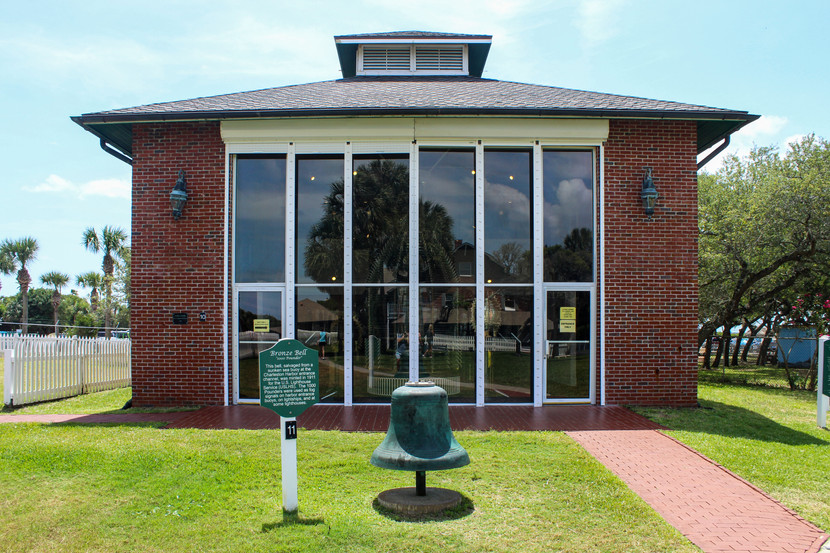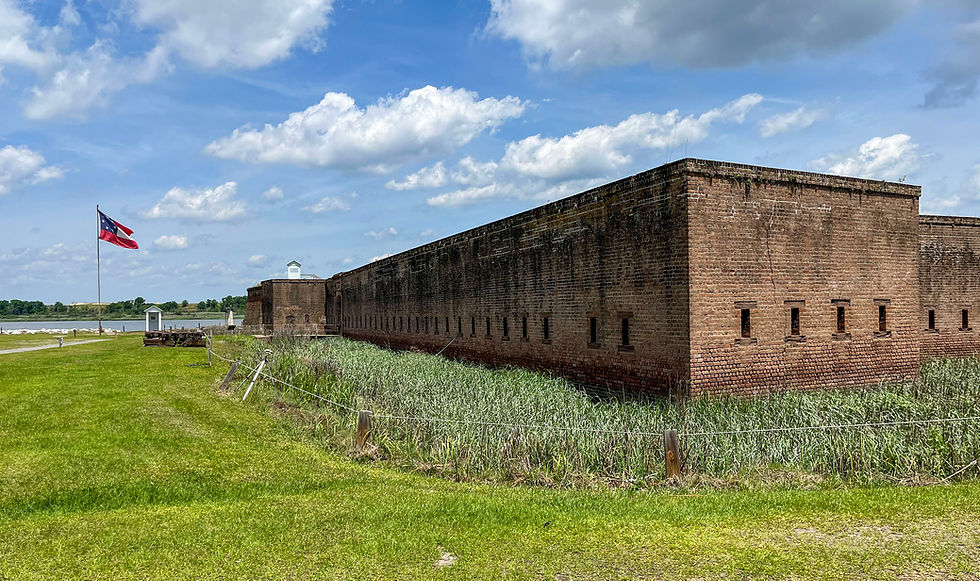Ponce de Leon Inlet Lighthouse and Museum
- Tim Murphy

- Mar 12, 2023
- 6 min read
Mosquito Inlet—first charted in April 1513 by Spanish conquistador Juan Ponce de Leon—was a relatively uninhabited estuary during the first two centuries of American colonization. Its treacherous shoals, erratic tidal currents, and frequent storms provided substandard conditions for permanent settlement. While under British occupation (1763 – 1784), Florida’s commercial prospects improved with the development of indigo and cotton plantations between Matanzas Bay and Cape Canaveral. Mosquito Inlet evolved into a bustling distribution center for raw materials; however, seafaring navigation remained extremely dangerous as several dozen ships wrecked along its coast.
In June 1834, Congress contracted Captain Winslow Lewis to construct Mosquito Inlet’s first lighthouse. Lewis’s design—a 45-foot, conical brick tower with eleven oil-burning lamps—was completed the following year for a sum of $11,000, yet the beacon was never operational. In October 1835, a series of strong storms undermined the tower’s foundation and washed away the keeper’s dwelling. Structurally unstable, the lighthouse was abandoned. Later that year on Christmas Day, Seminole warriors ransacked the vacant navigational aid in retaliation for Indian removal efforts, but the structure remained standing. Finally, on April 23, 1836, the decrepit lighthouse collapsed into the sea.

On August 7, 1882, Congress appropriated $30,000 for the second Mosquito Inlet lighthouse. General Orville E. Babcock was Chief Engineer of the project; however, his tenure would be short-lived. On June 2, 1884, Babcock was aboard the government schooner Pharos to deliver construction supplies for the lighthouse. A sudden storm aroused hazardous boating conditions and Pharos was unable to safely navigate the inlet. After impatiently idling in the ocean, Babcock and his associates boarded a skiff and attempted to row ashore. As they approached, vigorous swells capsized the vessel and flung Babcock into the undertow. His lifeless body floated onto the beach several minutes later. Two other crewmen—Levi Luckey and Benjamin Sutter—also perished in the tragic accident. Jared A. Smith succeeded Babcock as Chief Engineer and construction continued unhindered until December 1884 when the federal subsidy expired. Congress approved new appropriations in early 1885, but a rampant malarial fever prevented the resumption of work nearly six months.
In July 1885, Smith appointed Herbert Bamber as Superintendent of Construction for the Mosquito Inlet light station. Bamber gained recognition for inventing a “working platform”—an adjustable scaffold suspended by encircling steel cables that tightened against the tower with change in elevation. Per Bamber’s design, individual bricks were purposely left out of the exterior wall every ten feet to accommodate the framework’s support brackets. Once the tower was completed, bricklayers descended level-by-level to seal the remaining gaps. Bamber’s method increased the efficiency of masonry construction and became a standard modus operandi for future, government-funded brick lighthouse projects.
On August 31, 1886, while the tower was still under construction, an estimated 7.3-magnitude earthquake struck Charleston, South Carolina, sending shockwaves from Toronto to the Florida Keys. The Mosquito Inlet lighthouse sustained superficial cracks in its masonry, but government inspectors determined that the seismic activity caused no structural damage.
On November 1, 1887, after $200,000 of total construction costs, the Mosquito Inlet Lighthouse was illuminated. Five kerosene lamps powered the lantern’s first-order Fresnel lens, forming a single strong beam of light visible from upwards of twenty miles away. William R. Rowlinski—a Russian immigrant and Confederate veteran—was the lighthouse’s first Head Keeper.

During the Cuban War of Independence (1895 – 1898), federal revenue cutters frequently patrolled the Florida coast for filibusters—individuals who financed or engaged in unauthorized military activities—breaking American neutrality laws with Cuban revolutionaries. One such gunrunner was the S.S. Commodore, which departed from the port of Jacksonville on December 31, 1896, fully loaded with a half-ton of dynamite, forty rifle bundles, 204,000 rifle cartridges, and one thousand Hotchkiss shells. While on the St. Johns River, the Commodore struck a sandbar and damaged its hull. Although it was successfully towed out to sea, the ship’s water pumps malfunctioned, causing a leak to develop in the boiler room. On January 2, 1897, the sinking steamer came to an ominous standstill thirteen miles off the coast of Mosquito Inlet. The crew lowered the lifeboats and abandoned ship, but the rough seas caused one of the rowboats to careen back into the Commodore, stranding its hapless passengers on the foundering vessel, ultimately sealing their woeful fates.
Captain Edward Murphy, oiler Billy Higgins, cook Charles Montgomery, and journalist Stephen Crane—famed author of The Red Badge of Courage who served as a war correspondent for the Bacheller-Johnson newspaper—clamored onto a ten-foot dinghy and endured a grueling, thirty-hour excursion towards the distant light of the Mosquito Inlet Lighthouse. The choppy surf capsized the boat as it came ashore; Billy Higgins unfortunately drowned as a result. Crane later described this harrowing tale of survival in his popular short story, “The Open Boat.”

In 1927, Mosquito Inlet was renamed Ponce de Leon Inlet to recognize Florida’s Spanish heritage, acknowledge de Leon’s achievements, and entice more people to purchase real estate. Florida’s population influx augmented the arrival of modern conveniences, namely electricity, which began powering the lighthouse in 1935.
In 1939, the Coast Guard assumed control of the Lighthouse Service and offered active lighthouse keepers the opportunity to retire or join the armed forces. Ponce Inlet’s Principal Keeper, Edward L. Meyer, decided to join. He served with distinction at Ponce Inlet until December 1943, when he was replaced by Chief T.T. Galloway. During World War II, the keepers’ quarters were converted into barracks for coastguardsmen. A radio room was established in the First Assistant Keeper’s dwelling and was operational by August 1943.
Shoreline lights made seafaring vessels easy targets for German submarines. Civilian defense officials instituted coastal blackouts to combat this vulnerability. Being an aid to navigation, the lighthouse was dimmed from 500W to 50W, but it’s light could still be seen fourteen miles out to sea. Evidence of enemy activity frequently washed up near Ponce Inlet, with ship debris (and the occasional corpse) littering the beach.
In 1970, the Coast Guard abandoned the old light station, leaving it to the mercy of vandals and destructive natural elements. Two years later, the property was obtained by the Lighthouse Preservation Association and Town of Ponce Inlet. Extensive restoration projects transpired over the ensuing decades, culminating with the placement of a refurbished third-order, rotating Fresnel lens in 2004. Today, the historic Ponce Inlet Lighthouse persists as a private aid to navigation and maritime museum.

The Ponce de Leon Inlet Lighthouse and Museum offers the extraordinary opportunity to explore its navigational complex and learn about the region’s history. Beginning in the Woodshed Theater, visitors can view a twenty-minute documentary highlighting the light station’s storied past. Adjacent to the Administration Building is the Cuban Raft Exhibit. Prior to 1995, the United States Coast Guard had legal authority to rescue Cuban refugees found adrift in international waters and safely transport them to mainland America. However, following a revision to the Cuban Adjustment Act of 1966, the immigration policy changed. All expatriates found at sea would be returned to their place of origin, but if their vessels arrived on U.S. soil, they would qualify for permanent resident status. This became known as the “Wet Foot, Dry Foot” policy. The refugee rafts on display survived the perilous journey from Cuba to Florida. Their assemblers remain unknown.
The Second Assistant Keeper’s Dwelling is the first of three original buildings surrounding the light station. The home’s interior provides exhibit spaces dedicated to the lives of lighthouse keepers, legacy of the Lighthouse Service, and local history of Ponce Inlet. The Principal Keeper’s Dwelling (located directly to the east) also houses a variety of exhibits regarding the Indigenous history of Florida, the U.S. Life Saving Service, and lighthouse restoration efforts. The First Assistant Keeper’s home is not admissible, though curious guests can peer through its windows, revealing an interior furnished in turn-of-the-century style.
The Ponce Inlet Lighthouse is Florida’s tallest, towering 175 feet above the landscape. Its gallery deck offers a spectacular panorama of the Atlantic coast, although interested visitors must ascend 203 steps to appreciate the views. On the south side of the light station stands the Generator Building—showcasing radio station and weather monitoring equipment from World War II—and Lens Exhibit Hall, which houses a rare collection of lighthouse lenses and lanterns.
From shipwrecks to failed filibustering expeditions, The Ponce Inlet Lighthouse possesses a captivating maritime history that deserves recognition. The tower’s stateliness and architectural authenticity make it an indispensable piece of Florida’s heritage.
Visit PonceInlet.org to learn more about this historic light station
For more historical context, check out Volusia History, Lighthouse Friends, and Only in Your State
Click the following links for a Self-Guided Tour Map and Stephen Crane's account of the S.S. Commodore sinking
































